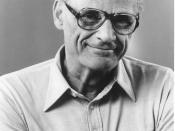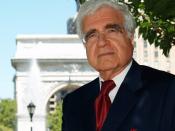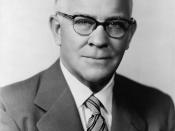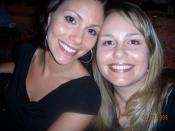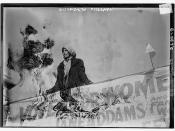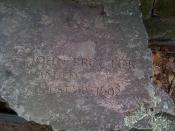The Crucible.
In 1962 in a small town called Salem, in Massachusetts, a group of teenage girls caused 100 or more trials and 14 deaths. The excuse for these accusations and trials was witchcraft.
260 years later Arthur Miller wrote a play called 'The Crucible', based on the witch trials in Salem. He was influenced to write this by McCarthyism.
This was a system set up by Senator Joe McCarthy. This was used by the government to find and stop people or organisations that were a threat to the United States of America.
McCarthy started arresting writers because he believed they were expressing communist views, and at the time America was under threat from communism.
During this time, in 1953, Arthur Miller wrote the play. He had been planning it for some time, but he felt that if he did it now it would be a political parable.
A few years after he wrote the play, he was arrested for expressing communist views.
The Crucible is a very dramatic and moving play. One of the ways it does this is by using strong speech. Another method that is used is playing with people's moral value, and their sympathy for certain characters.
First, I am going to look how the play uses suspense. It uses a traditional, but effective way, building the suspense up to the end of a scene, then dropping it back down again. For instance, the start of the first scene is the least dramatic part of the play. This is when Betty is asleep. The tension slowly builds up, ending with the girls accusing many of their enemies as being seen with the Devil. Abigail: "I saw goody Booth with the Devil" - bottom of page 40.
The tension then falls again at the start of scene 2, however this time it is a little greater than at the start of scene 1. Again it peaks at the end, this time with Elizabeth's arrest the centre of attention. This is full of suspense because of her moving speech- Elizabeth: "John, I think I must go with them (he cannot look at her). Mary, there is bread enough for the morning; you will bake in the afternoon. Help Mr Proctor as if you were his daughter- you owe me that, and much more. (she is fighting her weeping. To Proctor) when the children wake, speak nothing of witchcraft- it will frighten them (she cannot go on)" This wave pattern continues, ever increasing in height. By the start of scene 4's tension, it has reached the same height as that of the peak in scene 1.
The peak in the plays tension is when proctor tears up the confession- His breast heaving, his eyes staring, Proctor tears up the paper and crumples it, and he is weeping in fury, but erect. - Bottom of page 115. This is very near the end but not quite. The author lessens the tension at the end so he doesn't leave the audience in suspense and asking questions about what will happen.
I am now going to look at characters and how they are used in the play to add drama. First I am going to look at John Proctor. He is a main character and plays an important role in the play. Although he is not a strong speaker- Proctor: aye, the farm is seeded. The boys asleep? Middle of page 41, he
